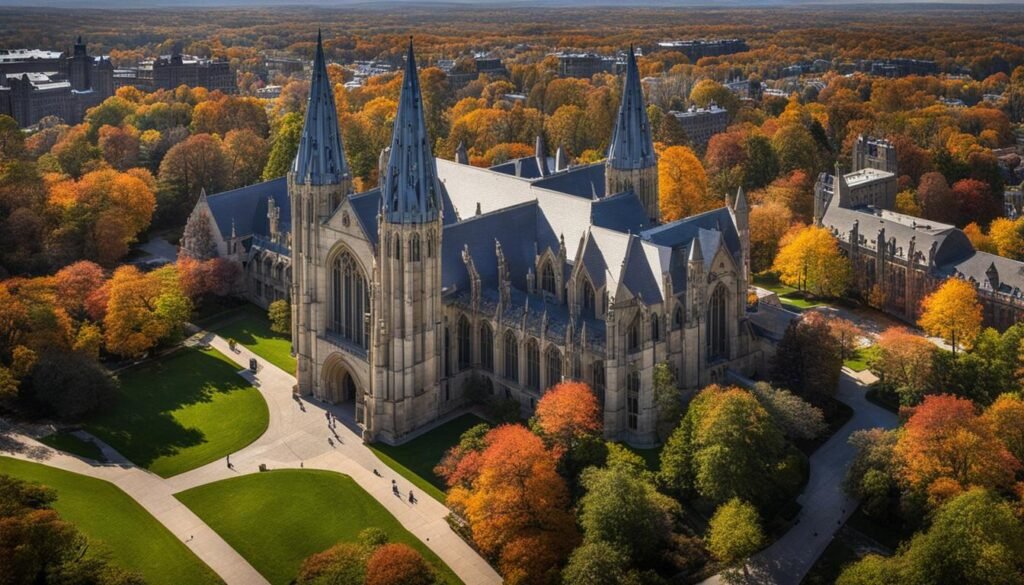When it comes to the educational background of US presidents, their college alma maters play a significant role. These institutions not only shape their academic journey but also provide insights into their formative years. From Ivy League universities to military academies, the alma maters of US presidents offer a glimpse into their diverse educational paths.
Among the many prestigious universities in the United States, Harvard University claims the distinction of having the most US presidents as alumni. With a total of 8 presidents attending Harvard, including John Adams, John Quincy Adams, Theodore Roosevelt, Franklin Roosevelt, and John F. Kennedy, it stands as a testament to the institution’s rich history and influence on American leadership.
Key Takeaways:
- Harvard University has produced the highest number of US presidents, with 8 alumni serving as presidents.
- Yale University follows closely with 5 presidents attending, including William Howard Taft and George H.W. Bush.
- The College of William and Mary, Princeton University, and the United States Military Academy at West Point have also contributed to the list of presidential alma maters.
- While many presidents attended Ivy League schools, other universities such as Stanford University and the University of North Carolina at Chapel Hill have also produced presidents.
- The educational backgrounds of US presidents vary, highlighting the importance of diverse pathways in achieving leadership positions.
Harvard University
Harvard University, founded in 1636, holds the distinction of producing the most U.S. presidents among all universities. With a total of eight presidents as alumni, Harvard has played a significant role in shaping the nation’s leadership. Notable presidents who attended Harvard include John Adams, John Quincy Adams, both Roosevelts, and Barack Obama.
Notable Alumni
- John Adams: The second president of the United States
- John Quincy Adams: The sixth president of the United States
- Theodore Roosevelt: The 26th president of the United States
- Franklin Roosevelt: The 32nd president of the United States
- John F. Kennedy: The 35th president of the United States
The Harvard experience has been a common thread among presidents, who have sought its prestigious education and intellectual environment. From its early years to modern times, Harvard University continues to produce leaders who have left an indelible mark on American history and politics.
Yale University

Yale University, located in New Haven, Connecticut, has a notable presence in the history of U.S. presidents. With a total of 5 presidents as alumni, Yale University stands as the second-highest producer of U.S. presidents.
Among the notable U.S. presidents who attended Yale University are William Howard Taft, George H.W. Bush, and his son, George W. Bush. Taft, who served as the 27th president of the United States, is also known for his role as the 10th Chief Justice of the Supreme Court. The Bush family legacy includes two U.S. presidents: George H.W. Bush, who served as the 41st president, and his son, George W. Bush, who was the 43rd president.
In addition to these presidents, Yale University also boasts the attendance of two other notable figures in American politics: Gerald Ford and Bill Clinton. Both Ford and Clinton attended Yale Law School, a prominent institution within the university.
Yale University Notable Alumni:
- William Howard Taft – 27th President of the United States and 10th Chief Justice of the Supreme Court
- George H.W. Bush – 41st President of the United States
- George W. Bush – 43rd President of the United States
- Gerald Ford – 38th President of the United States
- Bill Clinton – 42nd President of the United States
With its rich history and contributions to American politics, Yale University continues to be a prominent institution for aspiring leaders.
College of William and Mary
The College of William and Mary, established in the 1600s, is known for its historical significance and its esteemed alumni, which include three U.S. presidents. Thomas Jefferson, James Monroe, and John Tyler all attended the College of William and Mary, shaping their education and future careers.
Thomas Jefferson, the third president of the United States, studied at the college from 1760 to 1762. His time at the College of William and Mary laid the foundation for his political career and his role in drafting the Declaration of Independence.
James Monroe, the fifth president of the United States, also attended the College of William and Mary. He graduated in 1776 and went on to serve in various political positions before becoming president. His tenure is known as the “Era of Good Feelings,” marked by a sense of unity and national pride.
John Tyler: From William and Mary to the Presidency
John Tyler, the tenth president of the United States, is the third U.S. president to have attended the College of William and Mary. He graduated from the college in 1807 and served as a Virginia state legislator before entering national politics. Tyler’s presidency was marked by the annexation of Texas and the admission of Florida as a state.
The College of William and Mary continues to be a prestigious institution, offering a world-class education to its students. The legacy of Thomas Jefferson, James Monroe, and John Tyler serves as a testament to the impact that this institution has had on American history and leadership.
Princeton University
Princeton University, located in New Jersey, has produced two former U.S. presidents, James Madison and Woodrow Wilson. Both presidents have left a lasting impact on American history.
James Madison, the fourth president of the United States, attended Princeton University in the late 18th century. Known as the “Father of the Constitution,” Madison played a pivotal role in crafting and ratifying the U.S. Constitution. His education at Princeton University helped shape his political ideology and leadership skills.
Woodrow Wilson, the 28th president of the United States, not only attended Princeton University but also served as the university’s president. Wilson’s tenure as president of Princeton University from 1902 to 1910 was marked by significant reforms and improvements to the institution. His experience as an educator and administrator at Princeton University prepared him for the challenges he would face as president of the United States.
Princeton University Alumni
- James Madison – 4th President of the United States
- Woodrow Wilson – 28th President of the United States, also served as President of Princeton University
Princeton University continues to be a prestigious institution that produces influential leaders in various fields. The legacy of its alumni, including former U.S. presidents, serves as a testament to the quality of education and the impact of Princeton University on the world.
United States Military Academy at West Point

The United States Military Academy at West Point has produced two U.S. presidents who have left an indelible mark on American history. Ulysses S. Grant, who served as the 18th president of the United States, and Dwight D. Eisenhower, the 34th president, both received their education and military training at West Point.
Attending West Point is a testament to the commitment and dedication of these men to serve their country. The rigorous curriculum at the academy, combined with the military training, prepared them for the challenges of leadership and the responsibilities that come with the highest office in the land. Their experiences at West Point helped shape their character and instilled in them the values of duty, honor, and country.
Notable Achievements
- Ulysses S. Grant played a pivotal role in the American Civil War, leading the Union Army to victory over the Confederate forces. As president, he worked towards reconstruction and civil rights for African Americans.
- Dwight D. Eisenhower, a renowned military strategist, served as Supreme Commander of the Allied Forces during World War II. As president, he focused on domestic policies and successfully navigated the challenges of the Cold War.
The United States Military Academy at West Point continues to produce outstanding leaders who go on to serve the nation in various capacities. It remains a symbol of excellence and a testament to the importance of military education in shaping the leaders of tomorrow.
Other Universities and Presidents
While Harvard University and Yale University have produced the highest number of U.S. presidents, there are several other universities that have also contributed to the list of presidential alumni.
Stanford University
Stanford University boasts two U.S. presidents among its alumni. Herbert Hoover, the 31st president, and John F. Kennedy, the 35th president, both attended Stanford before entering politics.
University of North Carolina at Chapel Hill
The University of North Carolina at Chapel Hill is another institution that has seen its graduates rise to the highest office in the country. James K. Polk, the 11th president, and James Buchanan, the 15th president, both received their education at UNC Chapel Hill.
Georgetown University
Georgetown University, located in Washington, D.C., has also produced U.S. presidents. Bill Clinton, the 42nd president, and Lyndon B. Johnson, the 36th president, both attended Georgetown University Law Center.
University of Virginia
The University of Virginia, founded by Thomas Jefferson, is not only a historic institution but has also produced two U.S. presidents. Woodrow Wilson, the 28th president, and James Monroe, the 5th president, both earned their degrees from UVA.
These universities, along with others like Princeton University and Columbia University, have played a role in shaping the educational backgrounds of U.S. presidents. While Harvard and Yale dominate the list, these other universities have contributed significantly to the diversity of alma maters among U.S. presidents. It goes to show that leadership can be fostered in various academic institutions across the country.
Conclusion
In conclusion, the educational backgrounds of U.S. presidents vary, but the majority have received a college education. One prominent alma mater for U.S. presidents is Harvard University, which boasts the most alumni in the presidential seat. It is fascinating to note that out of the 8 presidents who attended Harvard, there are notable names like John Adams, Theodore Roosevelt, and John F. Kennedy.
Yale University is another institution that has contributed significantly to the U.S. presidency, with 5 presidents among its alumni. These include presidents such as William Howard Taft, George H.W. Bush, and George W. Bush. It is interesting to highlight that both Gerald Ford and Bill Clinton attended Yale Law School, further showcasing the importance of legal education in presidential careers.
Moving on, the College of William and Mary, one of the oldest higher education institutions in the U.S., has seen three of its alumni rise to the presidency. Thomas Jefferson, James Monroe, and John Tyler all walked the halls of this esteemed college, leaving their mark on American history. Similarly, Princeton University played a role in shaping the presidential landscape, with former presidents James Madison and Woodrow Wilson among its notable alumni.
While prestigious universities like Harvard and Yale dominate the list, it is worth mentioning that there are other institutions that have produced U.S. presidents as well. Stanford University, University of North Carolina at Chapel Hill, Georgetown University, and University of Virginia are just a few examples. These institutions continue to inspire future leaders to pursue a college education and follow in the footsteps of these influential figures in our nation’s history.
FAQ
Which university has produced the most U.S. presidents?
Harvard University claims the most U.S. presidents as alumni, with a total of 8 presidents attending.
Who are some notable U.S. presidents that attended Harvard University?
Some notable U.S. presidents who attended Harvard University include John Adams, John Quincy Adams, Theodore Roosevelt, Franklin Roosevelt, and John F. Kennedy.
Which university is the second-highest producer of U.S. presidents?
Yale University is the second-highest producer of U.S. presidents, with 5 presidents attending.
Which U.S. presidents attended Yale University?
U.S. presidents who attended Yale University include William Howard Taft, George H.W. Bush, and George W. Bush.
Which U.S. presidents attended the College of William and Mary?
The College of William and Mary has been attended by three U.S. presidents: Thomas Jefferson, James Monroe, and John Tyler.
Which U.S. presidents attended Princeton University?
James Madison and Woodrow Wilson, both former U.S. presidents, attended Princeton University.
Which U.S. presidents attended the United States Military Academy at West Point?
Ulysses S. Grant and Dwight D. Eisenhower are the two U.S. presidents who attended the United States Military Academy at West Point.
Are Harvard and Yale the only universities that have produced U.S. presidents?
No, there are several other universities that have produced U.S. presidents, including Stanford University, University of North Carolina at Chapel Hill, Georgetown University, and University of Virginia, among others.
Did all U.S. presidents attend college?
While the majority of U.S. presidents have received a college education, not all presidents attended college, and some did not even graduate from college.
Source Links
- https://en.wikipedia.org/wiki/List_of_presidents_of_the_United_States_by_education
- https://www.crimsoneducation.org/us/blog/which-us-college-educated-the-most-us-presidents/


